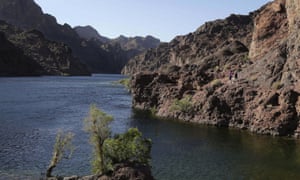As a fifth-generation rancher in Colorado, Paul Bruchez knows the value of water. Not only does he raise cattle irrigated by the Colorado River and its nearby tributaries, Bruchez runs a fly-fishing business on those same streams.
“My income, my life, requires a reliable water resource,” he said. But since moving to northern Colorado two decades ago, the Colorado River has shrunk by an average of 20% compared to last century. Climatic conditions are one culprit – the area is suffering the worst regional dry spell on record. But there’s another big problem.
Cows.
A recent analysis published in Nature found cattle to be one of the major drivers of water shortages. Notably, it is because of water used to grow crops that are fed to cows such as alfalfa and hay. Across the US, cattle-feed crops, which end up as beef and dairy products, account for 23% of all water consumption, according to the report. In the Colorado River Basin, it is over half.
“There’s many smaller streams that have been dried up completely,” said Brian Richter, the study’s lead author and the president of Sustainable Waters, a water conservation non-profit. “We’re only seeing the beginning of what’s going to become a major natural resource issue for everybody living in the western United States.”
Agriculture accounts for 92% of humanity’s freshwater footprint across the planet, and has long been identified as a major culprit in drought. But the new study suggests how extreme its impact can be.

“The fact that over half of that water is going to cattle-feed crops just floored us,” Richter said. “We had to double and triple check to make sure we got the numbers right.”
Lake Mead, in Arizona and Nevada, for example, hasn’t been full since 1983, and has fallen by almost two-thirds in the last 20 years alone. According to Richter’s analysis, almost 75% of that decline can be attributed to cattle-feed irrigation.
In the Colorado River Basin as a whole, which services around 40 million people in seven states and is overtaxed to the point that it rarely ever reaches the ocean anymore, that number is 55%.
It takes a lot of water to make a double-cheeseburger. One calculation puts it at 450 gallons per quarter-pounder. The study also found that most of these water-intensive beef and dairy products are being consumed in western cities. “Beef consumers living in the Los Angeles, Portland, Denver and San Francisco metropolitan areas bear the greatest responsibility for these hydrological and ecological impacts,” Richter and his colleagues reported.
Around 60 species of fish in the western US are experiencing increased risk of extinction due to draining water tables, according to the study. As streams dry up, toxic chemicals such as fertilizers and pesticides that run off from farms become concentrated, suffocating river-dwelling fauna. Invasive species can find a foothold in the changing environment.
It’s a dire situation, but people like Richter and Bruchez are working on solutions. For the past 18 years, Bruchez has been involved with local water sustainability efforts, including several multimillion dollar river restoration projects, and champions strategies like improved irrigation systems and rebuilding riparian habitat.

The most cost-effective solution, proposed in Richter’s paper, is fallowing farmland, meaning letting it sit idle, without irrigation. “You can’t get more water savings off of an acre than by not watering it,” Richter said, and described it as “growing water” rather than a crop. He noted that the strategy should be temporary and rotational, and that ranchers should be compensated because they lose income growing nothing. Fallowing is at least twice as effective as other water-saving tactics, according to Richter’s analysis.
Agricultural strategies aside, people who eat beef and dairy will ultimately need to consume less or choose products that don’t depend on irrigated crops fed to cows, Richter said. Plant-based meat alternatives can play a role, as one analysis found that a meatless Beyond Burger generates 90% fewer greenhouse gas emissions and has practically no impact on water scarcity.
“Reduced consumption of beef is one very effective way for an individual consumer to reduce their water and energy footprint; however, it is difficult to guarantee that there would be a subsequent decrease in water stress in the western US with decreased beef consumption,” Dr Shelie Miller, the director for University of Michigan’s Program in the Environment, said in an email. “Even with decreased water consumption associated with beef and dairy, there are a multitude of competing water demands in the western region of the US.”
In other words, even if beef and dairy are sucking American rivers dry, addressing cattle-feed crops is only part of the solution to growing water scarcity.
Bruchez, the rancher, is concerned about “the volume of water that is used to put into people’s yards, parks, golf courses, whatever for scenery”. Agriculture, he said, “isn’t in my eyes the only thing to look towards”.
Credit: Source link






























